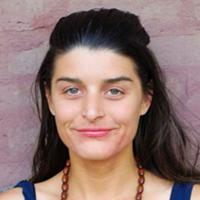
[Editor's note: Rather than look back over the year that was, the Tyee is offering its readers a dozen New Ideas for the New Year. We'll publish a new one every weekday from now through Jan. 1. They're textbook cases of thinking outside the box, all of them from people trying to make B.C. a better place to live. Later in January we'll be asking you to suggest your own new ideas for 2008, and publish a selection.]
Ruben Anderson has a dream: one day the sidewalks of Kitsilano will be as congested with pear trees as they are with Peg Perego strollers.
Italian bakeries lining the Drive will harvest fresh fruit from neighbouring yards to make prize-winning pastries.
The Eastside will be famous for pistachios, not poverty.
Anderson's prescription is for Vancouver to invest in civic pride and local culture by planting fruit and nut trees in the city's neighborhoods.
Side effects may include increased food security and reduced carbon in the atmosphere.
"Trees have a bunch of benefits just by being there," says Anderson. "They reduce storm water overflow, they sequester carbon, they shade buildings and reduce urban heat island effect, they increase the value of property."
Hundred-metre cider
While these impacts are positive in themselves, Anderson says planting specific species in different neighbourhoods offers more: an extremely localized food economy as well as an impetus for people to connect with one another.
"We should plant each variety in a different area. What that would set the stage for is harvest festivals that would move throughout the city."
At the Commercial Drive apple festival, for example, residents could enjoy "hundred-metre cider," says Anderson, and local bakeries could compete for the tastiest pie prize.
"When we get sentimental about lost culture, we are often talking about food. Things like this will help change that," he says, adding that neighbourhood specific trees offer a "huge cultural potential" that hasn't been recognized.
"These harvests could represent a new neighborhood culture . . . residents are going to love it."
Beyond the Fruit Tree Project
The food potential from local fruit and nut trees has been recognized already. In 2005, Vancouver parks board commissioner Allan De Genova called on the city to expand urban orchards as part of its sustainable food policy.
He brought forward a motion to plant 600 fruit and nut trees across the city. About 150 have been planted already, with the rest scheduled to be in the ground by next spring.
De Genova says the motion was part of a collective agreement with community groups who intend to harvest the fruit when it's ready in another three to five years.
The Fruit Tree Project is already at work in Vancouver. This organization helps residents with under-picked fruit trees in their backyard connect with local groups and individuals who can harvest the surplus.
Anderson says such trees should be more integrated into the public sphere.
"Right now there are not many cities that are utilizing their street trees very well. We kind of put them up as ornaments," he says.
If food-bearing trees were allowed to proliferate on the city's streets and public areas, the result would be "millions of pounds of fruit and nuts," says Anderson.
"Easier access to fresher food at more affordable prices," he says. "That would be an enormous benefit to food security . . . and a source of pride and community identity."
Related Tyee stories:
- 100-Mile Diet
Eating a truly local diet for a year poses some tricky questions. - Social Fertilizer
The big growth potential of urban agriculture. - Slow Food's Growing Pains
Want to eat local? You'll have to get in line.
















